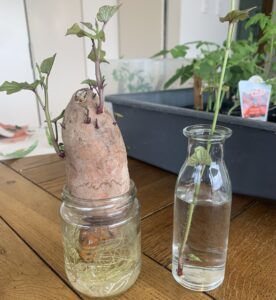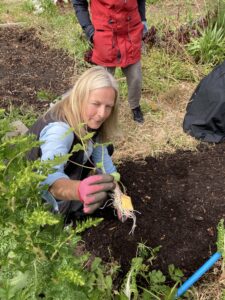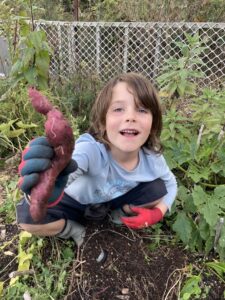Mahi Ngātahi
Enviroschools and Garden to Table have been supporting kaiako on a kūmara growing journey over the course of a year, so that they have the knowledge to support tamariki to connect with te taiao through their food gardens. Termly māra kai clusters started with sustaining summer gardens and themes of the māra as an opportunity to connect with the local curriculum, the Aotearoa New Zealand histories curriculum, a ‘wellbeing’ space for tamariki and observing the maramataka.
Learning Journey

Getting root growth on tipu before planting.
A dedicated learning journey began in September 2023 with a cluster hosted by Te Kura o Ngā Puna Waiora/Newtown School and supported by Seeds to Feeds. Growing tipu (the rooted shoots/slips), planning a bed and planting were topics covered. Olivia and Victoria from Garden to Table shared their knowledge to help kaiako get started. Fourteen kaiako from kindergartens, primary and secondary schools from Wellington’s eastern, southern and western suburbs attended.
The group created a spreadsheet to track their learning through the project. It was used to share successes and challenges with growing the tipu, and capture the following information: type and source of kūmara, method used for growing (e.g. in a box of sand, in a jar, cut from parent tuber/plant or in a saucer), then length of time to sprout and harvest tipu.
Building Knowledge
In November 2023 Kaicycle Urban Farm hosted an event at a plot on the Kaicycle farm, for kaiako to continue building knowledge of how to plant the tipu.
This included:
- kūmara like warmth, so ensure the bed is north facing or sheltered from southerly winds
- plant into compost, on a hard pan
- plant the tipu in a ‘J’ shape
- plant with some comfrey and mounded into ‘puke’
- leave to grow for 120-150 days
- water with diluted seaweed tea.

Kaiako, Jo Harvell of Cardinal McKeefry School, planting tipu at Kaicycle Urban Farm.

Learning together and sharing knowledge about planting at Kaicycle Urban Farm.
Harvest and Storage
In March 2024 seventeen kaiako were hosted at Tapu Te Ranga Marae to learn how to harvest kūmara tubers that formed beneath the healthy vegetative runners. The harvesting and storing session was in collaboration with Playcentre and many kaiako attending were the bi-cultural officers for their centres. We had waited over 120 days for the tubers to develop underground BUT we also wanted them harvested before it got cold (frost arrived) and weather started to get wetter.
To harvest:
- remove gently so to minimise damage to them
- gently dig them out with (gloved) hands or a garden fork
- It is a treasure hunt! You might need to go quite deep and tubers on top might be small
- Brush off dirt (don’t wash/avoid getting them wet), and ‘cure’ by placing somewhere for them to dry out a little (indoors/ under cover).
You can eat them straight away but many of us wanted to wait for Matariki. Curing them will make them last (and become a bit sweeter). Wrap in newspaper and place in a box, store somewhere that is dry (be mindful of any moisture in your garden sheds or kitchens).
Full Cycle

A busy learning environment at the harvest and storage session at Tapu Te Ranga Marae.
During term 1 2024, schools were connecting with their local whenua through Education Outside the Classroom week. Having a teacher cluster hosted at Tapu Te Ranga Marae supported the hāpu to share their history, their aspirations and to build connections with local schools and early childhood centres to attend their Matariki event this year. The kūmara were harvested and while they may not feed the numbers expected at Matariki events, they were healthy! This gave everyone encouragement and enthusiasm to try again with kūmara growing in the next planting cycle.
Planning for Matariki has been a lens to explore sustainable celebrations and waste systems in learning centres. We held a student event looking at low waste ideas for Matariki events, that can be taken on as everyday practices as a follow on.
Kaiako have always brought tamariki along to these sessions and locally sourced kai provided nourishment and manaaki for all attending. One kaiako commented on how well organised the session was and the diverse range of kaiako that were brought together through this wonderful context.

Sweet success at harvest time.